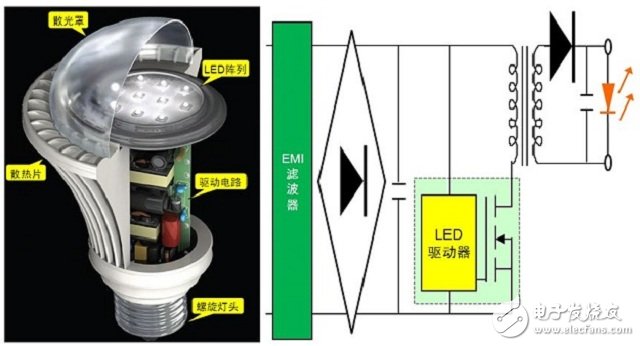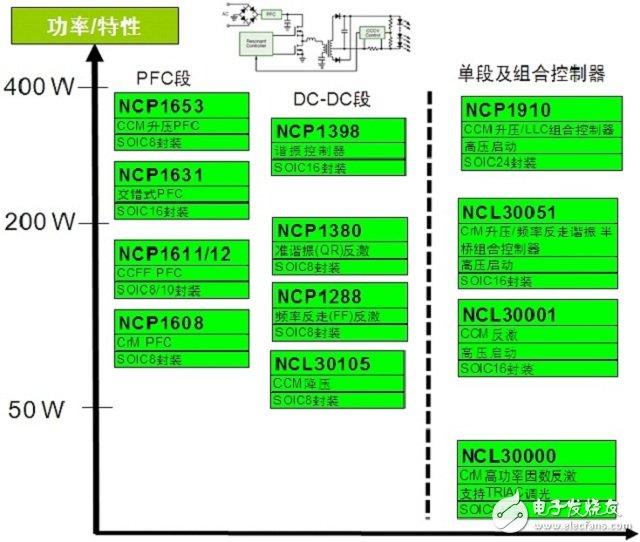Lighting power is an important source of energy consumption worldwide. According to projections, China's lighting electricity accounts for about 12% of the total electricity consumption of the whole society. Among various lighting fixtures, the application of incandescent lamps with a long history but low energy efficiency is still very extensive. If the use of low-energy-efficiency light sources is limited, and the promotion and application of more energy-efficient and environmentally-friendly light sources will be conducive to energy conservation.
Therefore, including China, many countries in the world have formulated policies to phase out incandescent bulbs in stages. For example, in 2015, China plans to eliminate all of the incandescent bulbs for general lighting above 60W. Fluorescent lamps and compact fluorescent lamps (CFLs) are more energy efficient than incandescent lamps and have been used in the market for many years. However, fluorescent lamps contain highly toxic substances, and environmental concerns are increasing.
In comparison, LEDs are increasingly improving their performance in terms of luminous efficiency, and they are also environmentally friendly and have long-life characteristics. In fact, LED downlights and retrofit bulbs already have higher energy efficiency than current lighting technologies such as incandescent, halogen or CFL. In terms of cost, the study found that compared with 2010, the price of LED has accelerated (down 13% to 24% per year), and it is expected to continue to decline in the next few years, which will help reduce the cost of LED bulbs and lamps.
Therefore, countries around the world are optimistic about and promote the development of the LED lighting industry. For example, the National Development and Reform Commission of China issued the “Semiconductor Lighting Energy Conservation Industry Planâ€, which plans to have a market share of LED functional lighting products of more than 20% by 2015, and the LED lighting energy-saving industry output value will increase by about 30% annually, with an output value of 450 billion in 2015. Yuan (equivalent to 72 billion US dollars).
LED general lighting application and development prospects
In addition to a wide range of applications, such as mobile devices, large-size liquid crystal display (LCD) backlights and LED signage, LEDs are now increasingly used in LED automotive interior/exterior lighting, such as headlights, fog lights, and taillights. , parking lights, dashboard backlights, roof lights, reading lights and ambient lights, as well as LED lighting for residential lighting and building decoration lighting.
LED general lighting applications cover a wide power range, from 3W to 15W LED residential lighting, medium power with 15W to 75W commercial and building decorative lighting, up to 75W to 250W outdoor and infrastructure lighting, typical lighting products are like MR16/GU10 lamps, E27/A19 bulbs, ballasts, downlights, T8 tubes, street lights, etc.

Figure 1: Typical LED general lighting application
LED general lighting applications are promising. Among the various LED general lighting fixtures, the recent development of LED bulbs (such as A19 LED bulbs) is staggering. According to statistics, in 2012, global LED bulb shipments reached 735 million, and it is expected to grow to 1.225 billion in 2013. It is expected that by 2014, the LED bulb market will be ignited, and the price of LED bulbs will drop to US$10. Below, shipments are expected to increase by approximately 85% from 2013 to 2.27 billion; and shipments will further increase to 3.9 billion by 2015.
Energy-efficient drivers are the focus of LED general lighting
To maximize the energy-saving features of LED lighting, you need energy-efficient LED drivers. Let's take LED bulbs as an example. Typical LED bulbs contain LED arrays, drive circuits, diffusers, heat sinks and spiral bases, as shown in the left half of Figure 2. As far as the driver circuit is concerned, the energy-efficient LED driver IC is undoubtedly the focus. The right half of Figure 2 shows a typical LED bulb drive circuit using a typical stand-alone LED driver.

Figure 2: (a) cross-sectional view of a typical LED bulb (left); (b) typical LED bulb drive circuit (right)
To take advantage of the energy-efficient LED general-purpose lighting, LED drivers have multiple challenges. The first is that energy efficiency is essential. Taking LED bulbs as an example, its shape is fixed and heat dissipation is limited. The use of energy-efficient LED drivers can help convert more energy into light energy and help dissipate heat. Secondly, LED bulbs have limited space and require a larger heat sink area, especially for larger power bulbs. In addition, LEDs are rapidly changing, offering a variety of options that also pose challenges to the choice of LED drivers. Since the space of the LED bulb is limited, it is necessary to reduce the size of the driving electronic circuit to increase the remaining space and to cooperate with heat dissipation. LED general illumination covers different power levels, so LED driver selection must be optimized to match different lighting and power requirements. For safety and LED selection, designers must also consider whether to use isolated or non-isolated topologies, which also affects the choice of LED drivers.
ON Semiconductor's driver solution for LED universal lighting
ON Semiconductor actively promotes energy-efficient innovations, including energy-efficient electronic innovations, including LED lighting, covering a wide range of market segments for LED lighting, such as mobile devices, LCD backlights, LED signage, automotive and general lighting. Among them, LED general lighting is now the focus of ON Semiconductor in the lighting market. In the LED general lighting market, ON Semiconductor's strategy is to take advantage of the company's broad lineup of analog power ICs, discrete devices and advanced micro-packages to provide a distinctive energy-efficient LED driver solution.
ON Semiconductor offers LED driver solutions covering a wide power range and different topologies. ON Semiconductor's drives for low-power LED general-purpose lighting applications include the NCL30000, NCL30002, and NCL3008x series. Among them, NCL30000 is a single-stage power factor correction (PFC), LED driver that supports TRIAC dimming, and uses a secondary-side controller to support topologies such as flyback/buck/buck-boost. The NCL30002 is also a single-stage power factor-corrected LED driver that supports a buck topology with ±3% current tolerance. The NCL3008x family currently includes devices such as the NCL30080, NCL30081, NCL30082 and NCL30083, and is a new energy-efficient quasi-resonant controller for low-power LED lighting applications.
It is worth mentioning that the NCL3008x series adopts the novel control method of Primary Side RegulaTIon (also called primary side control or primary side control), eliminating the need for secondary side control circuits and optocouplers. Constant current regulation of the LED current from the primary side helps simplify PCB layout, save board space, improve energy efficiency, and simplify safety analysis (see Figure 3, left). In addition, it offers high current regulation accuracy, wide forward voltage drop (Vf) range, low electromagnetic interference (EMI) and integrated rugged protection. These devices offer a power factor of 0.8 to 0.9, which meets the power factor requirements of the US Energy Star for LED bulbs with power greater than 5W (PF 0.7).

Figure 3: (a) NCL3008x novel primary-side control technology (left); (b) N193008x-based A19 bulb reference design (right)
ON Semiconductor also developed a reference design for a compact A19 LED bulb based on the NCL30082 (see Figure 2, right). This reference design is optimized for isolating flyback or non-isolated buck-boost topologies optimized for 10W LED lighting applications. It uses a valley filled PFC to meet the "Energy Star" power factor above 0.7. The dimensions of the PCB and components are targeted at 22x60mm cylinders. Tests have shown that this reference design provides high energy efficiency, high power factor and high current regulation accuracy.
In terms of medium power and high power LED lighting, ON Semiconductor also offers a rich product portfolio to meet different application needs of customers. It includes both single-stage and combination controllers as well as a traditional two-stage (PFC section + DC-DC section) controller covering a wide power range from 15W to 400W, as shown in Figure 4.

Figure 4: ON Semiconductor's driver for medium-to-high power LED general illumination
As can be seen from Figure 4, single-stage power factor correction LED controllers such as NCL30000 and NCL30001 can be used in medium power LED general lighting applications; in more powerful applications, NCL30051 and NCP1910 can be used. Energy efficient combination controller. Take the NCL30051 as an example. This is a power factor correction (PFC) and resonant half-bridge combination controller optimized for off-line LED lighting applications that provides a constant voltage for step-down DC-DC converters/LED drivers. The device integrates a critical conduction mode (CrM) PFC controller and a half-bridge resonant controller with a built-in 600V driver optimized for off-line power applications with all the features needed to achieve an energy efficient, small form factor design .
In addition to the single-stage solution described above, designers can also choose the traditional two-stage (PFC section + DC-DC conversion section) solution according to the application requirements. Specifically, the controllers that can be selected for the PFC section include NCP1653, NCP1631, NCP1611/NCP1612, and NCP1608. Among them, NCP1611 /2 is an enhanced energy-efficient PFC controller based on the innovative current control frequency back-off (CCFF) architecture. When the PFC inductor current exceeds the set value, the circuit usually works in critical conduction mode (CrM). When the current is lower than the preset value, the switching frequency is linearly reduced to approximately 20 kHz, at which time the current is zero. The CCFF architecture also maximizes rated load operating efficiency and light load energy efficiency, especially for minimizing standby losses, including flat panel TVs, all-in-one computers and high-power power adapters, as well as LED lighting power supplies and drivers. Dimming fluorescent lamp ballasts, etc.
In the DC-DC section, optional devices include NCP1398, NCP1380, NCP1288, and NCL30105. In addition to these devices, ON Semiconductor is also developing more new devices to meet the wider application needs of customers.
For the 22kV Oil Immersed Power Transformer, we can produce capacity upto 420MVA. We use the best quality of raw material and advance design software to provide low noise, low losses, low partial discharge and high short-circuit impedance for power transformer.
Our power transformer are widely used in national grid, city grid, rural grid, power plant, industrial and mining enterprise, and petrochemical industry.
220Kv Transformer,220Kv Power Transformer,High Quality Power Transformer,Oil Immersed Transformer
Hangzhou Qiantang River Electric Group Co., Ltd.(QRE) , https://www.qretransformer.com